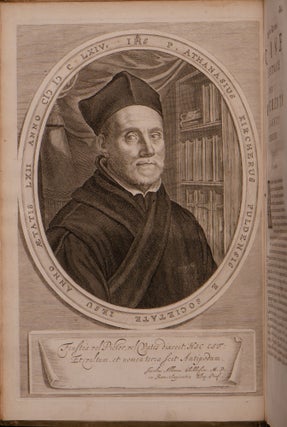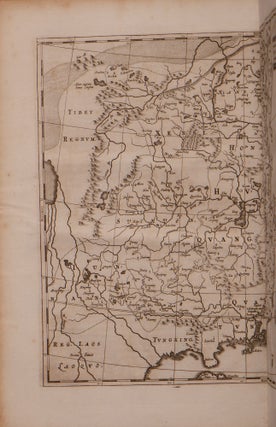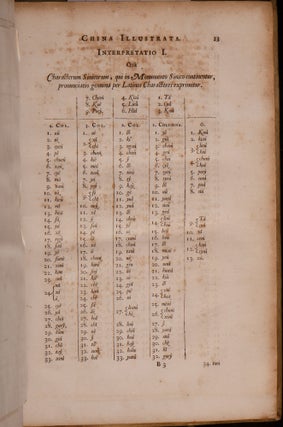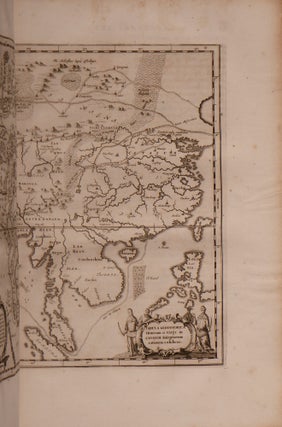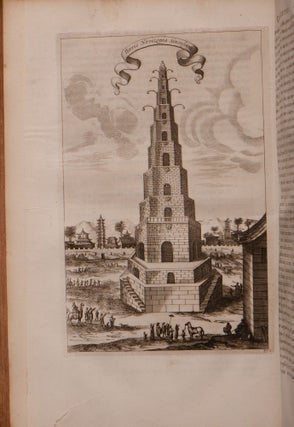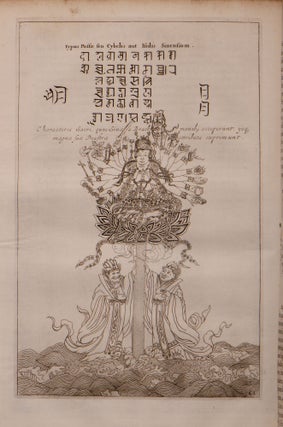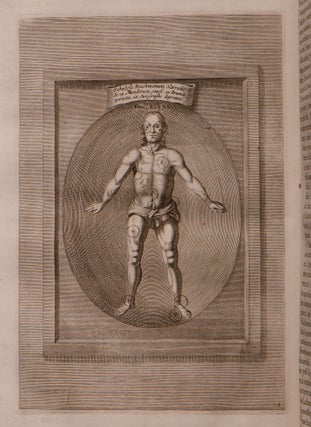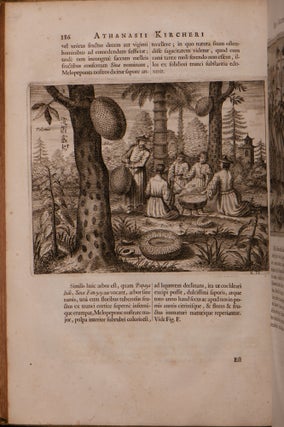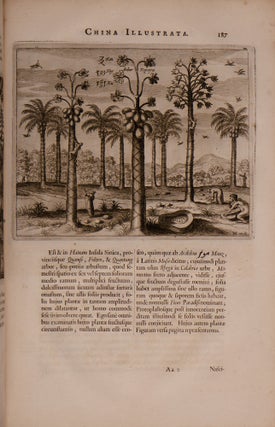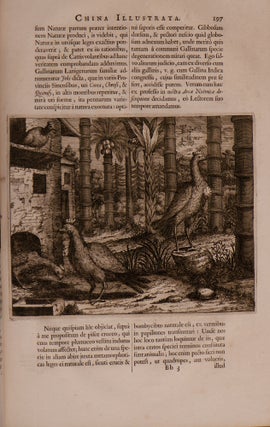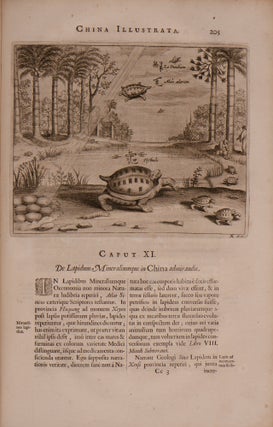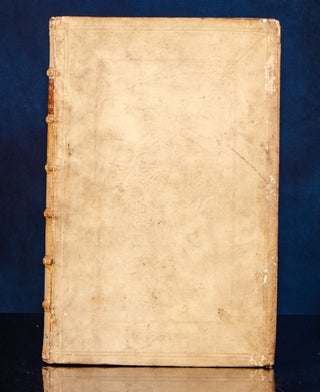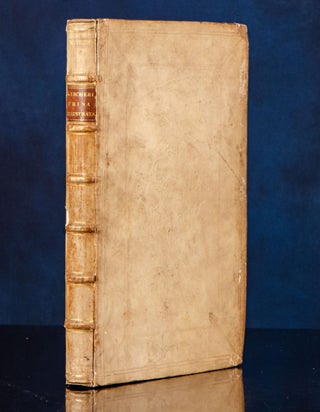China Monumentis
Amsterdam: Johannes Janssonius van Waesberge et Elizium Weyerstraet, 1667. Item #05517
The True First Edition of Kircher's China Monumentis
KIRCHER, Athanasius. China Monumentis, qua Sacris quà Profanis, Nec non variis Naturae & Artis Spectaculis, Aliarumque rerum memorabilium Argumentis Illustrata. Amsterdam: Johannes Janssonium á Waesberge & Elizium Weyerstraet, 1667.
First edition. Large folio (14 3/4 x 9 9/16 inches; 375 x 243 mm.). [*4], [**4], 1-237, [238-248, index] pp; [*4], [**4], A4 - Gg3, index Gg4 - Hh4; 8 preliminary leaves (incl. the engraved title). Finely engraved allegorical frontispiece title-page (Amsterdam: J. Jansson à Waesberge & E. Weyerstraet, 1667), letterpress title-page with printers woodcut vignette, engraved portrait of the author. Twenty-three engraved plates (one of which is folding), two double-page engraved maps, and fifty-nine engravings in the text.
Early vellum over boards, covers ruled in blind and with central blind-stamped device. Spine with five raised bands, ruled in gilt. Red morocco label lettered in gilt. Endpapers renewed many years ago, all edges stained red. Upper and lower joints cracked but sound. A wonderful example with the plates and maps bright and fresh and with no repairs or restoration.
"The True First Edition of Kircher's profusely illustrated account of China [China, Illustrated with Monuments, Both Sacred and Profane, and Various Spectacles of Nature and Art, and Proofs of Other Memorable Matters.] based on descriptions by many European explorers, including many Jesuits such as Kircher himself. [This], the true first edition is larger in size, the Amsterdam and Antwerp counterfeit prints of the same year are about 5 cm smaller and with the engravings redone. The engravings are based on these explorers' sketches and original images imported from Asia. This work includes the first Chinese vocabulary ever printed in the West . . . the standard text for the study of Chinese until the nineteenth century" (Merrill).
"China, like Egypt, was to Kircher an ancient and mysterious land, highly civilized, filled with strange creatures and unimaginable marvels, and, above all, having an origin and universality common with all nations… China had been open to Christian missionaries for only a few decades when Kircher, at 28, applied to go there. He was refused, but the refusal only whetted his curiosity. Over the next 37 years he maintained a voluminous correspondence with fellow Jesuits in China, gleaning all the information he could from their letters and journals. Most notable among his sources were Johann Adam Schall von Bell (1591-66), missionary in China from 1622, reviser of the Chinese calendar, and chief of the Bureau of Mathematics and Astronomy in Peking; Martino Martini (1614-61), Kircher's former pupil, mathematician of the Chinese imperial court, and author of the first detailed map and geographic description of China, Novus atlas sinensis (1655); and Johann Grueber (1623-80), who went to China in 1656, became assistant to Schall, and returned to Rome in 1661. Yet another important source is Michael De Boym (162-59), a missionary in India from 1643 and in China from 1650. De Boym returned in 1652 to Eurpoe, whhere he published his Flora sinensis (1654), a description of China's flowers, fruits, fruits and animals. Kircher's major source was undoubtedly Matteo Ricci's Commentaries (1615), the account of the Jesuit missions in China from their inception in 1582 until Ricci's death in 1610...
China illustrata is a compilation of these missionaries' notes and journals. Kircher readily acknowledges in the preface his debt to his colleagues in China and India for the information, but the book is liberally sprinkled with Kircher's own philosophy. Kircher compiled a detailed and considerably accurate account of Chinese geography, history, culture, and language, and, as his readers had learned to expect, the book is filled with delightful engravings illustrating the curious habits of the Chinese..." (Merrill, pp. 47-49).
"…China illustrata is a compilation of these missionaries' notes and journals. Kircher readily acknowledges in the preface his debt to his colleagues in China and India for the information, but the book is liberally sprinkled with Kircher's own philosophy. Kircher compiled a detailed and considerably accurate account of Chinese geography, history, culture, and language, and, as his readers had learned to expect, the book is filled with delightful engravings illustrating the curious habits of the Chinese.
The book is divided into six parts. The first discusses the famous Nestorian inscription, written in Chinese with a portion in Syriac. The monument was erected by Nestorian missionaries near the city of Hsi-an fu in A.D. 781, establishing the incursion of Christianity into China as early as the eighth century. The transcription and transliteration, together with Father Michael De Boym's translation of the inscription, first printed here by Kircher, constitute the first Chinese vocabulary ever printed in the West. It became the standard text for the study of Chinese until the nineteen century... The second part gives a history of China and of her introductions to Christianity... Idolatry, the subject of part 3, was considered yet another Egyptian influence in China... He includes a Sanskrit grammar and vocabulary prepared by the intrepid Jesuit explorer, and the first European to master the Sanskrit language, Heinrich Roth. This was the first printing of a Sanskrit grammar and of the Devanagari script in Europe, and it, like the Chinese vocabulary in the same work, became the primary source for the study of the language... Part 4 Kircher devoted to describing China's government, its cities, and its natural wonders - mountains, lakes and rivers, plants, animals, and minerals. Part 5 details China's architectural and mechanical marvels, such as the great bells of Peking. Finally, in part 6, Kircher returns to the Chinese language and the origins of its characters." (Merrill, pp. 49-50).
Merrill 20; Brunet III, 666-67; Caillet II, 361.5773; Clendening 9.14; De Backer I, 428-29.21; Ebert 11397; Graesse IV, 21; Sommervogel IV, 1063-65.24.
Price: $12,500.00

 I have been in the rare and antiquarian book business for over forty years; my family has been in the rare books business since 1876. Rare books are in my blood.
I have been in the rare and antiquarian book business for over forty years; my family has been in the rare books business since 1876. Rare books are in my blood.


